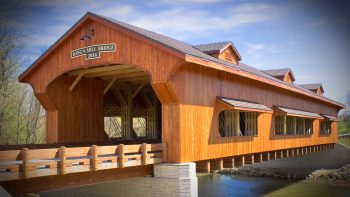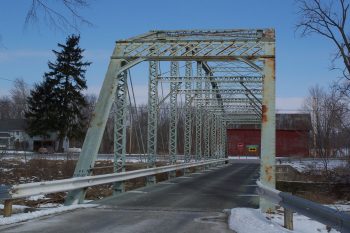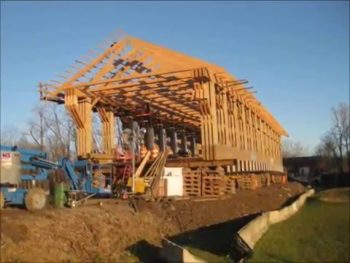
Some of the best treasures are the ones discovered without expectation. Such is the case, often, with the Kings Mill Bridge as it spans the Olentangy River, southeast of Marion on St. James Road.
The bridge was built in 2016, but captures the essence of the historic covered bridges that have attracted millions nationwide. The structure, designed by Smolen Engineering Ltd. and built by RG Zachrich Construction, is composed of massive wooden beams, steel bolts, and many hand-crafted pieces. The picturesque setting of the massive wooden structure just above the flowing river is postcard-worthy.
 The original bridge was a 190-foot, single-lane, steel high truss bridge that had become expensive to maintain and was due for major rehabilitation, according to the Marion County Engineer’s Department, which is responsible for maintaining 279 bridges in the county. Although old, it was technologically significant as one of Ohio’s most complete, surviving examples of a sloped-chord, long-span, pin-connected highway truss bridge. The former bridge’s steel superstructure dated back to around 1900 and originally crossed the Scioto River at Marion Marysville Road in the 1910s before a Works Progress Administration project moved it to the St. James Road location in 1937.
The original bridge was a 190-foot, single-lane, steel high truss bridge that had become expensive to maintain and was due for major rehabilitation, according to the Marion County Engineer’s Department, which is responsible for maintaining 279 bridges in the county. Although old, it was technologically significant as one of Ohio’s most complete, surviving examples of a sloped-chord, long-span, pin-connected highway truss bridge. The former bridge’s steel superstructure dated back to around 1900 and originally crossed the Scioto River at Marion Marysville Road in the 1910s before a Works Progress Administration project moved it to the St. James Road location in 1937.
The new King’s Mill Bridge was constructed out of wood for a myriad of reasons, among those being sustainability, aesthetics, ease of repair, and durability in the Ohio climate. The bridge’s construction cost $3.2 million, making it Marion County’s largest bridge project to date. It was paid for with federal and local bridge replacement funding and money from a road fund generated from gas taxes. It measures 190 feet long and 28 feet wide. The arch measures 18 feet, 8 1/2 inches high.
“Wood is an excellent material for building bridges,” said designer John Stolen, an engineer from Ashtabula County, which is home to 12 historic covered bridges and hosts the annual Ashtabula Covered Bridge Festival  each October. “Wood excels in bridges because it’s not harmed by road salt, unlike steel and concrete. Timber is also lighter, with a higher strength to weight ratio than concrete and it’s a renewable resource.” Smolen estimates there are 145 historic and new wooden covered bridges in Ohio.
each October. “Wood excels in bridges because it’s not harmed by road salt, unlike steel and concrete. Timber is also lighter, with a higher strength to weight ratio than concrete and it’s a renewable resource.” Smolen estimates there are 145 historic and new wooden covered bridges in Ohio.
Marion’s covered bridge design has a mix of features from three new bridges in Union County, and has a basic structure similar to the Mill Creek Bridge near Ostrander in Delaware County, with asphalt paving over a wooded deck and glue laminated wooden supports, tongue and groove cider shingle side panels and a steel roof design to look like shakes. Steel rods laced throughout the structure maintains the tension of the sides, which afford open views to the river.
“We have received strong public support with this bridge,” said Marion County Engineer Brad Irons. “People call us every day telling us how beautiful the bridge is.”
Since its opening three years ago, visitors have flocked to the Kings Mill Bridge, making it one of the most photographed sites in the county, next to the Harding Memorial. The newest county landmark has been part of thousands of prom pictures, family photos, and even marriage proposals, and was recognized at the 2019 Celebrate Marion Gala in the category of “Places.” A small parking area adjacent to the bridge gives easy access to tourists and those who wish to visit the attraction. The bridge is also regularly occupied by fishermen casting lines into the scenic river.
“There are many, many people who are fascinated with covered bridges, both the original ones from the late 19th and early 20th century and these newer ones,” said Mark Holbrook, executive director of the Marion Area Convention and Visitors Bureau. “Folks will travel just to drive across and look and photograph covered bridges. There aren’t that many covered bridges you can drive across still. And they did use original covered bridge techniques. All the trussing is the same as what would’ve been used 100 or 150 years ago.”
The bridge’s name stems from a deep history. The land was originally settled by Titus King in 1830. The family built a mill on the Whetstone River in southeast Marion County near Waldo.
#MarionMade #WeAreBridges


















